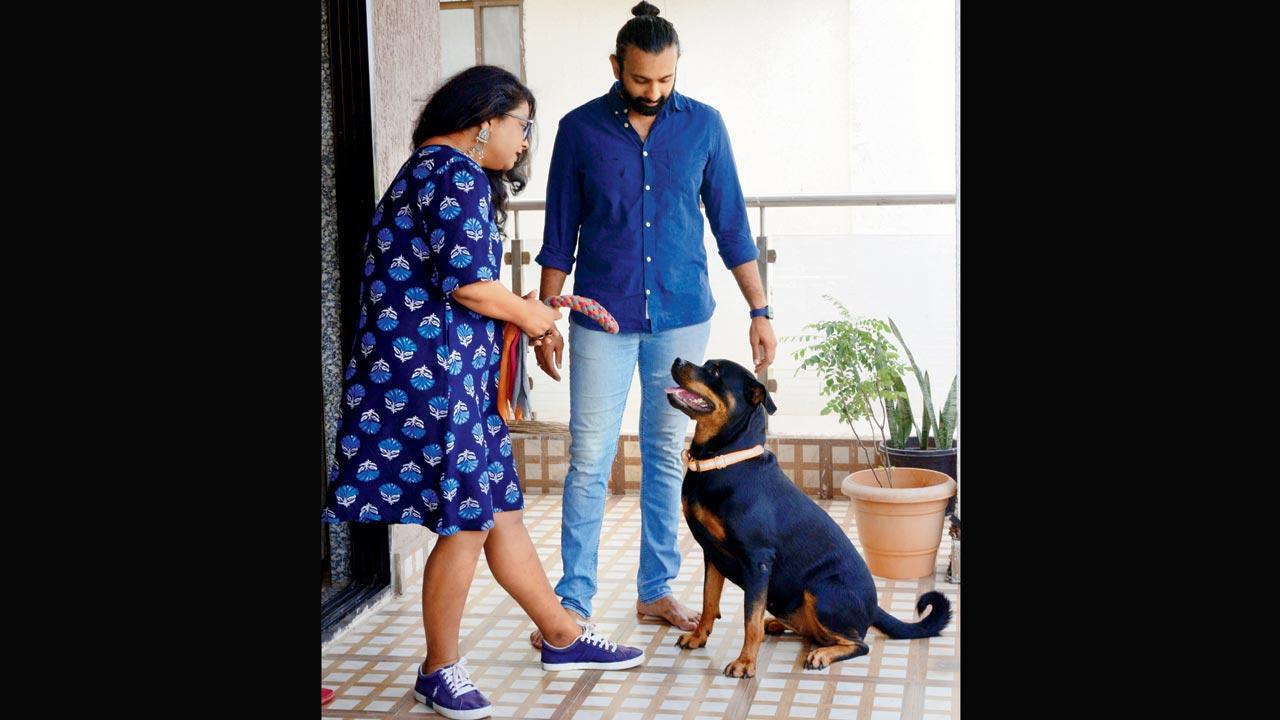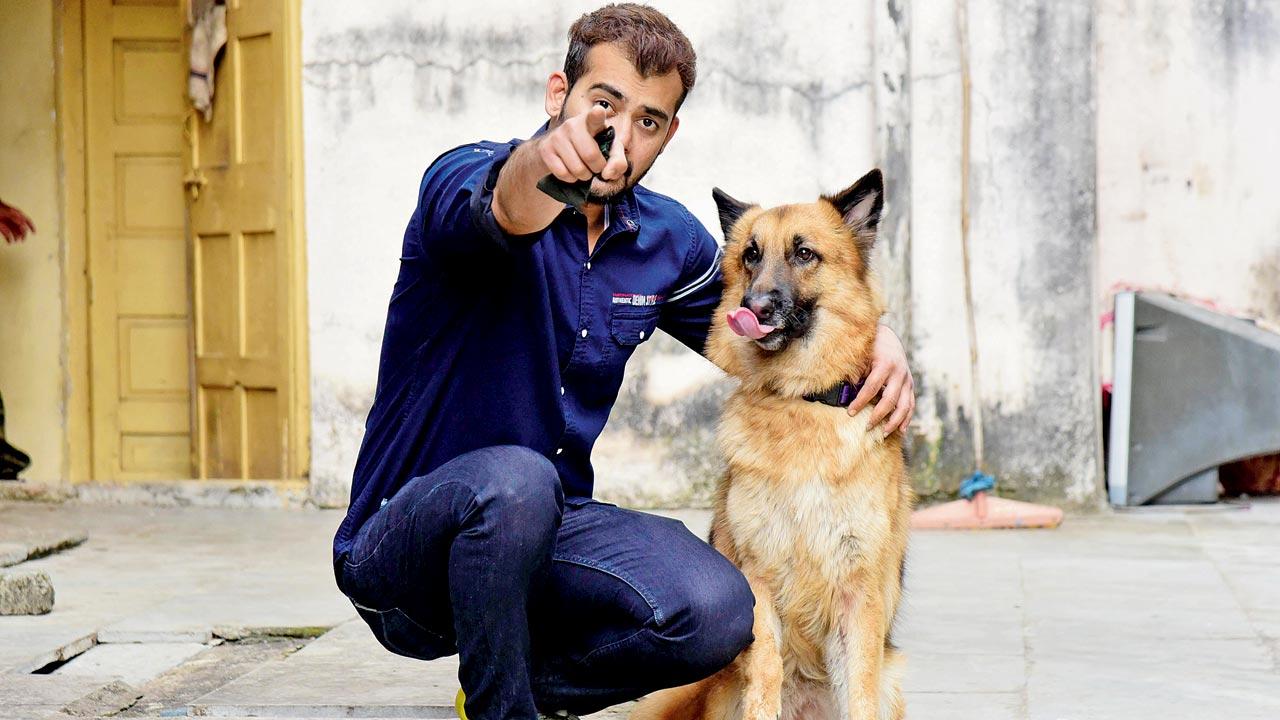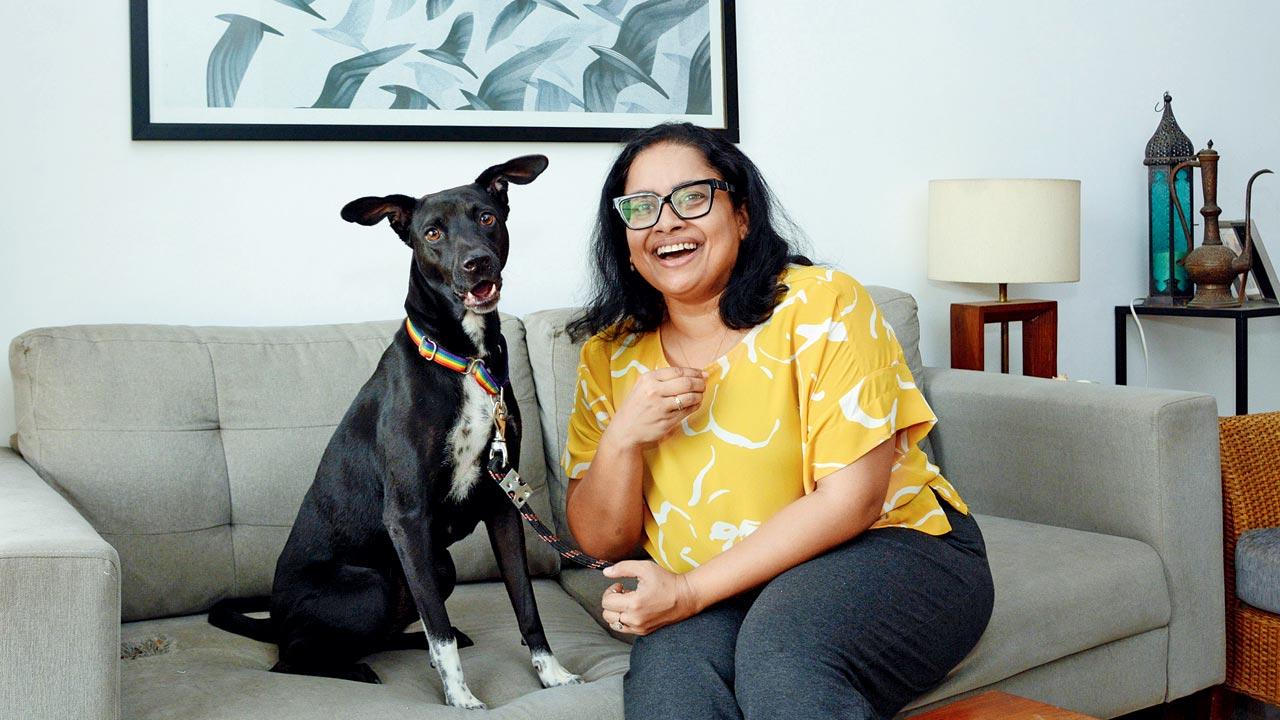With the Mumbai police dog, a Belgian Malinois, biting his new handler last week, could it have been more than his genetic disposition? While some dogs are genetically guarded, sometimes, we inadvertantly teach them aggression

Meenakshi Bhanj Deo and Vikram Mittal exposed Tara to as many people, places, sights and sounds as possible by taking her everywhere. As much as Tara loves cuddles, only her parents are allowed to do so. Pics courtesy/Ashish Rane
On any given day, the marvellous Miss Maple is a goofy, adventurous dog with a bow on her collar. The three-year-old Indie and her parent Amrita Chatterjee make up their cheery household. Yet one thing Chatterjee knows not to do is force her affections on Maple if she’s not in the mood; usually indicated by her sitting under a table, sofa or bed. “When I thought of getting a dog, I imagined a ‘conventional’ relationship,” says the 45-year-old. “She would love hugs and kisses, follow me everywhere, listen to what I said and cuddle on the sofa or bed with me.”
Their real life could not be further away from the truth. Maple is being trained to like the muzzle, so that she can get medical care; and taught the command ‘Place (go to a designated area)’ so that she can go to the innermost room of the house, barricaded by a baby gate, when guests come over.
“When I was looking to adopt, I was told, ‘All a dog needs is food and love’,” says Chatterjee, the marketing honcho of a luxury brand. “I knew I didn’t want to buy a dog; I had heard so many horror stories about puppy mills. I wanted to adopt an Indie to defy that ‘purebred dogs are the best’ nonsense.”
 German Shepherd Whiskey, who is a member of the Mumbai Police Dog Squad, with her handler. Pic/Suresh Karkera
German Shepherd Whiskey, who is a member of the Mumbai Police Dog Squad, with her handler. Pic/Suresh Karkera
The Vashi resident soon learnt that the Indian street dog has breed traits and proclivity towards certain behavior, each entrenched deeply for survival. Resource guarding–being possessive of food, toys, areas of rest; being touch shy—for generations, a streetie has learned that humans don’t have the best intentions and is better to avoid them. Indies also tend to be high-strung, i.e. get into fight or flight at the slightest noise because in their natural habitat, they run the risk of being mowed over.
The first crack in their picture-perfect companionship came when Maple was a year-and-half old. That’s towards the end of a dog’s teens, when s/he starts asserting themselves and pushing boundaries. “She gave out a soft growl and snapped in the air when my mother went to pet her on the head while Maple was asleep,” says Chatterjee. “We just put it down to a ‘bad mood’ and didn’t think much about it.”
 Amrita Chatterjee is training Maple to wear a muzzle without resistance to bring down the possibility of bites to zero. Pics courtesy/Ashish Rane
Amrita Chatterjee is training Maple to wear a muzzle without resistance to bring down the possibility of bites to zero. Pics courtesy/Ashish Rane
But things really changed after Chatterjee returned from a two-week trip abroad. She started to allow her to sleep on the bed with her, and Maple started showing preference for one corner on the couch. “She would jump and lick my friends, but snapped at the landlord one day. She also growled and snapped at the house-help, but since I wasn’t home during those incidents, I assumed it was a case of miscommunication between species.”
To a canine behaviourist, this would be the start of a journey towards territorial aggression.
Slowly, the incidents grew: A snap at Chatterjee when she went to touch Maple’s head as she was gnawing on a chew stick; Growling when anyone came near her corner; Snapping at Chatterjee when her leg touched Maple as they slept together on the bed; Biting a child who went to pet Maple, despite Chatterjee’s warning; She also chomped on the child’s bottom as she ran away. The crescendo to this was a bad bite on a cousin’s face that needed several stitches.
In Chatterjee’s words: “My cousin had come home with her dog. Maple and him barked their head off at each other. Eventually, we kept one in a bedroom, and Maple was tethered by her leash to the grill of the balcony, while I sat close to her. My father video-called me, and I invited the cousin to come sit next to me so that we could all chat. Before I knew it, Maple bit her face multiple times, closely missing her eye.”
 Leena Ukil
Leena Ukil
Chatterjee doubled her training efforts. “Maple is taking well to all the alterations in her life,” she says, “She took to the crate easily, but doesn’t like the gate being closed, so I have started training her to go to the bedroom when someone comes. She is very good about getting off the bed or sofa when I ask her to. She still allows me to squish and cuddle her, but I have to read her mood right. If she is stressed, say, by the sound of crackers bursting while we walk, she will be cranky.”
The challenge for Chatterjee are animal lovers she meets on walks who cannot conceive that a dog would not like them. “I warn them that she doesn’t like to be touched,” she says, “but they impose regardless which sets her off.”
Canine behaviourists or dog trainers who have formally studied canine behavioural science, divide aggression into genetic, learned and fear-based reactions. When the Mumbai police dog, a Belgian Malinois, bit his new handler last week, behaviourists were not quick to cry foul. To them, the dog may have a genetic predisposition but there’s something more: He had not bit his original handler. So it could have been an angry response after a series of events that pushed the dog to lash out.
Behaviourist and aggression consultant Leena Ukil, who is also a human geneticist, says a genetic disposition to aggression shows itself in puppyhood and becomes extremely clear in the teenage years. “If you do anything that pushes the puppy’s limits,” says the 42-year-old, “like, say, take something away, they will snarl and hold their position. Other puppies would be confused momentarily and then give in.”
She says all the teenage dogs try to push their limits. “Hey, take me seriously. I’m an adult now,” they want to say. “But if a dog with a genetic pre-disposition to a defiant personality is mishandled by inexperienced parents between the ages of two to seven months, the genetic tilt becomes stronger,” she says. Mishandling doesn’t have to be something overt, like snatching a dangerous item from the dog’s mouth, she says. “Even an enthusiastic game of fetch, where you take the ball from the dog’s mouth instead of teaching her to drop it, can lead to possessiveness,” says Ukil. “As can an authoritative, overbearing human. Dogs have conscious personhood and must be allowed to make choices. They have a right to be upset. With training, we can guide them towards the right ones, but if the attitude is ‘in my house you are not allowed to have an opinion’, the aggression will manifest quicker.”
Luckily, in some dogs, say the German Shepherd, you can rewire some of the behaviour until age one, after which it becomes more or less permanent. “Genetics is a bunch of switches,” says Ukil, “There are some you cannot change, but you can turn related switches so high that the undesirable is pushed into the background.”
She gives the example of food aggression, characterised by a dog growling or snarling when a human approaches it while eating. This is perfectly normal behaviour in an Indie, who needs to safeguard its meals from others. Food is the number one resource. “But if we over-feed the puppy from the very beginning in multiple places,” she says, “it creates an illusion of abundance and the puppy may have a far lower reaction to you coming near its bowl.”
Training, she says, gives the dog other options to exercise. Playing breed-specific games to channel their natural instinct is another way to veer a dog away from the big A, and a high level of socialisation.
Entrepreneur Meenakshi Bhanj Deo wanted to get a dog desperately, but she knew she didn’t want a Rottweiler. “I knew it was one of the so-called ‘dreaded’ breeds but my husband Vikram [Mittal] wanted one, so, I gave in,” says the Parsik Hill-resident. While every puppy goes through the phase of stealing chappals and socks, Bhanj Deo was aware of a Rottweiler’s predisposition to guard resources.
She noticed right off that Tara would not let go of chappals or socks easily and so she started working on strengthening the ‘Drop it’ command. “Her favourite game is tug with a particular tug toy,” says Bhanj Deo, “So, unless she brings it to me and drops it, we don’t start the game. We have to do this daily, about six to eight times, and if we lapse for a few days, the drop weakens.”
‘Socialisation’ is a misunderstood term: Pet parents define it as getting their dog to play with other dogs, while trainers and behaviourists say it is getting the puppy used to as many sights, sounds, smells, places and people as possible.
To dilute her Rottweiler disposition, Bhanj Deo began socialising Tara the day she came home. “I was very clear that I didn’t want my social life to be affected,” says the 42-year-old. “We took her to farmer’s markets [where the couple would market their brand of fermented drinks and condiments], to friends’ and neighbours’ houses... she volunteered on several dog trainer courses so that she could get used to human handling. Our house sees a lot of footfall of friends and staffers.”
Even as a puppy, Tara did not like her head being touched, and Bhanj Deo worked on that actively. Yet the preference remained. In her teen years, the now three-year-old Tara began hating the sight of other dogs. This has affected the quality of their
“There are friends that she loves to cuddle and play with,” says Bhanj Deo , “But we follow a strict protocol with guests ‘No touching’. We tell them to shower affection by playing a game with her; physical affection is not the only way of showing love.”
Pandemic puppies–dogs who came home in 2020/21—lacked opportunities for socialisation. And misinformed socialisation—pet parties, play dates, parks, fairs, fetes and other social events—are a breeding ground for dog-to-dog aggression. “Over friendly dogs are problem dogs,” says Varuna Kaur, an internationally certified
trainer and behaviourist. “Even off-leash play time amongst many dogs from one housing complex can be chaotic and overwhelm a puppy or dog. It’s where they pick up bad habits—chasing each other, rough play, bullying, etc.”
A puppy could be easily scarred by a dominating large dog who chases or snaps at him. To a young, impressionable puppy or even a teenager, this first encounter leaves a permanent impression. When s/he sees that this works in keeping the fearsome dog away, it becomes a go-to habit for the rest of her/his life. “Even the best trained dogs,” says the Sion-resident, “become aggressive. I am working with a German Shepherd, who was perfectly trained, but has become aggressive towards dogs now.”
“A dominating kind of dog,” says the 31-year-old, “will use aggression to get things his or her way. It happens in a house where the rules are not consistent or applied by every family member. So you will have a dog who snaps when you tell her to get off the sofa, or go towards the kitchen. You’ll see that the dog runs the house.” Varuna gets two to three aggression cases a week.
Eventually, such dogs become unfit to live among humans and long-stay at a kennel or a farm is the best solution. Zavareh Daruwala, proprietor of the Fitpet Kennel in Khandala, takes in two to three dogs aggressive dogs every month. “These dogs are aggressive in their territory,” says Daruwala, “When they come here, it’s our territory and they are at a disadvantage so they behave themselves.” Daruwala has tales of Dobermanns who’ve taken a chunk of flesh from their human’s thigh, become loving puppies in the kennel, living out their lives there without an accident. French Bulldogs given up for biting children can be held by the staff in their arms. “Most of these city dogs are frustrated from being cooped up,” he says. “There’s a lot of input in the form of rich food, but no output in terms of energy.”
In a farm or kennel, there is no sofa that the humans want you to get off of, or to come kiss when the dog is sleeping. They are left alone to eat. Most of the aggression disappears with fading triggers.
Srinivas Jakkani sees multiple cases of aggression a week—an Akita who has nearly torn out her owner’s lips, a Chow Chow who has received an ultimatum from the housing society after he bit neighbours, and his family, numerous times. Indies, Shih Tzus, Cocker Spaniels and St Bernards who would not be described as anyone’s best friend. “After missing the crucial socialisation period and exercise due to the lockdown, many dogs carry a lot of stress in their system,” says the 31-year-old Chembur resident. The cases of aggression post pandemic increased to eight to 10 a week.
Too much handling also leads a dog the same path. “In a household with kids, tails and ears are pulled, there is the uncomfortable picking up the dog frequently,” says the trainer and behaviourist, “the first few bites are warning bites. The Chow Chow was sleeping when its human went to kiss him. The parent got two bites on the eye and cheeks.” Some dogs display PTSD type signs, erupting in anger at something innocuous like cleaning ears or wiping the eye. The dog stops trusting the approaching hand.
Jakkani adds that the most times, there is no research into the breed. For instance, the Chow Chow was a travelling larder for the marauding Mongolian, providing fur and meat. So, they are not used to be cuddled. “Very often a child will see a cute or exotic looking dog on social media, and demand it,” he says. “Forcing dogs to ‘say hello’ to other dogs on walks, is another factor.” On his board-and train facility in Thane, PetWags, Jakkani does not take in more than three aggressive dogs at a time. “It’s not fair to my staff; they deserve to be around good dogs,” he says, “One aggressive dog is equal to three dogs in terms of work. It will have to be fed, exercised and groomed with extra care and patience.”
A certain Mastiff is legendary in the canine profession. As a biter, he was shunted from house to house, his aggression getting bad with each rehoming. Having gained notoriety in Mumbai, he was given to a family in Goa. The mother was battling cancer, and father was managing two young children and stressed by huge medical bills. A well-meaning trainer advised exercise as the remedy—accumulatively six hours. The dog bit one of the children and was sent to a kennel. There, he attacked a staffer. The man was barely able to save himself and landed in the ICU. Faced with life of imprisonment with no medical care, the dog had to be put down.
 Subscribe today by clicking the link and stay updated with the latest news!" Click here!
Subscribe today by clicking the link and stay updated with the latest news!" Click here!










